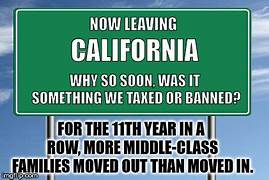Want a job? Want more money? Want to be safe? Want your kids to get an education? If your answer is yes to these questions, then your answer is YES to leaving California.
“Consider how often employment declines between quarters as one yardstick of job loss. Since 1990, the number of U.S. jobs fell 21% of the time between quarters. In California, it was 24%.
So, if you’re seeking stability, consider states where quarterly job drops were the least likely, such as Colorado and Texas, where they occurred just 12% of the time. Next was Nevada at 13% and Florida, which ranked 12th-lowest at 17%.
California has a great future for the rich and the illegal. Everyone else will have to pay for rich and illegals to live a great life.
Leaving California? Here are the best job markets out there

Utah, Texas at top of rankings. Rhode Island, Michigan were last.
By JONATHAN LANSNER, Orange County Register, 4/5/23
One reason folks relocate from California is employment opportunities.
So, as a public service to those thinking about departing the Golden State – and to share some job market history lessons – my trusty spreadsheet dug up some data on solid paychecks. Looking at employment stability in other state job markets using data dating to 1990, Utah is the nation’s most stable job market.
Next comes California nemesis Texas, then North Dakota, South Dakota, Idaho and Montana. Oh, and California’s other big economic rival, Florida, ranked No. 13.
At the same time, job seekers should avoid Rhode Island, Michigan, West Virginia, Hawaii and Connecticut.
Now any Californian hunting for out-of-state work should understand how job markets act differently over time. Understandably, there are no guarantees in job searches or workplace longevity. But do you want to uproot yourself – or a household – for a job market prone to sharp gyrations?
With all the chatter about a California population exodus, here’s a look at the hiring habits behind these rankings that are based on seasonally adjusted measurements of job creation and unemployment patterns.
What’s the hiring pace?
A state’s job growth is a key element for any relocation hunt that focuses on paychecks.
For starters, note that the U.S. job market grew at an average 1% annual rate in the past 33 years while California’s grew 1.1%.
With those benchmarks in mind, note that Nevada had the swiftest hiring among the states, growing 2.9% a year. Next was Utah at 2.7%, Idaho at 2.5%, Arizona and Arizona at 2.3% and Texas at 2.1%. Florida was No. 7 at 1.8%.
The slowest growth was found in Connecticut at 0.1%, Rhode Island at 0.3%, Michigan and Ohio at 0.4% and West Virginia at 0.5%.
How often are jobs lost?
Hiring always has hiccups. Layoffs are part of life.
Consider how often employment declines between quarters as one yardstick of job loss. Since 1990, the number of U.S. jobs fell 21% of the time between quarters. In California, it was 24%.
So, if you’re seeking stability, consider states where quarterly job drops were the least likely, such as Colorado and Texas, where they occurred just 12% of the time. Next was Nevada at 13% and Florida, which ranked 12th-lowest at 17%.
On the other hand, job losses happened the most in West Virginia, down in 38% of all quarters, then Connecticut at 35%, Michigan at 34% and Vermont at 31%.
Where are jobs stable?
We know hiring is an up-and-down occurrence.
The geeky volatility measurement known as “standard deviation” can help gauge the relative size and frequency of economic movements. This math tells that U.S. job growth typically swung 1.2 percentage points – up or down – from its average during the past 33 years. In California, it was 1.4 points.
So for folks who prefer stability, the least volatile job markets, by this math, were in Arkansas, Oklahoma, Nebraska, South Dakota and Utah.
But fast-growth Nevada was also the most volatile job market, gyrating 2.3 points – almost twice the U.S. norm. Then came Hawaii, Michigan, Rhode Island and New York.
Rivals Texas was the seventh-most stable while Florida ranked No. 29 most volatile.
Who’s unemployed?
Another way to eyeball a job market’s quality is its jobless rate. And since 1990, official joblessness has averaged 5.6% nationally. In California, it was 7.2%.
Nebraska was lowest at 3.2%, then North Dakota and South Dakota at 3.3%, Iowa at 4% and Utah at 4.1%. High rates were found in D.C. at 7.4%, Alaska at 7%, West Virginia and Michigan at 6.8% and Mississippi at 6.7%.
Rivals Texas was No. 29 at 5.8%, and Florida was No. 26 at 5.6%.
Joblessness jumps?
In the past third of a century, U.S. unemployment rates increased between quarters 35% of the time. In California, it was 32%.
If you want to minimize such swings in your life, history says Massachusetts was lowest at 22%. Then came Florida at 24%, North Dakota at 26%, Georgia at 27% and Iowa at 28%. Texas was No. 21 at 35%.
The most upticks were seen in Nebraska at 44%, Louisiana at 43%, Delaware and Illinois at 42% and South Carolina at 41%.
Where is unemployment steady?
That same geeky deviation measurement shows the U.S. unemployment rate has typically bounced 1.6 percentage points, up or down, from its average over 33 years. In California, it was 2.4 points.
Career calmness, by this math, was found most often in South Dakota, Nebraska, North Dakota, Wyoming and Alaska. Texas was the 16th calmest.
At the other end of the jobs spectrum, Nevada was highest again at 3.2 percentage points, again double the U.S. norm. Then came Michigan, Rhode Island, Florida and Hawaii.
So what are your chances?
Fancy formulas that track job growth don’t get you hired. Bosses adding staff does.
Since 1990, the nation has added 43 million jobs – with 5 million in California.
But if you want to go where hiring happens the most, then Texas is your spot: up 6.3 million workers in 33 years.
Next was Florida at 4 million, Georgia at 1.8 million, North Carolina at 1.7 million and Arizona at 1.6 million.
Bottom line
There are numerous ways to tally the quality of a job market, and everyone’s employment needs are different.
So this scorecard, or any other job-tracking grades, is simply a rough guide.
Numerous Californians have migrated to Nevada’s up-and-down, but mostly up, job market. It ranks No. 27 on this scorecard. Neighboring Arizona scored a No. 7 ranking. And by the way, California, if included in these rankings, would have been a sub-par No. 33.
Let’s remember that hiring patterns are frequently driven by factors within individual industries. Job markets with heavy concentrations in volatile businesses – think of technology, energy, real estate or tourism – will often seem riskier. But slow-and-steady is not always better.
Don’t forget, too, that “hot” local economies sometimes have unexpected twists of fate. Those shocks can come from global forces, neighboring communities or in-state changes.
So be prepared for job market surprises, especially in fast-growth towns.
And, yes, I know relocating for a job isn’t for everybody. But a lot of people think so.
Retirees may focus on a state’s cost of living or leisurely amenities. Similar logic may be inside the thinking of a remote worker seeking a new home.
But stuff happens. Retirees can get bored or they can run short of cash. And employers can change their thinking about out-of-office work.
So, jobs really matter.



